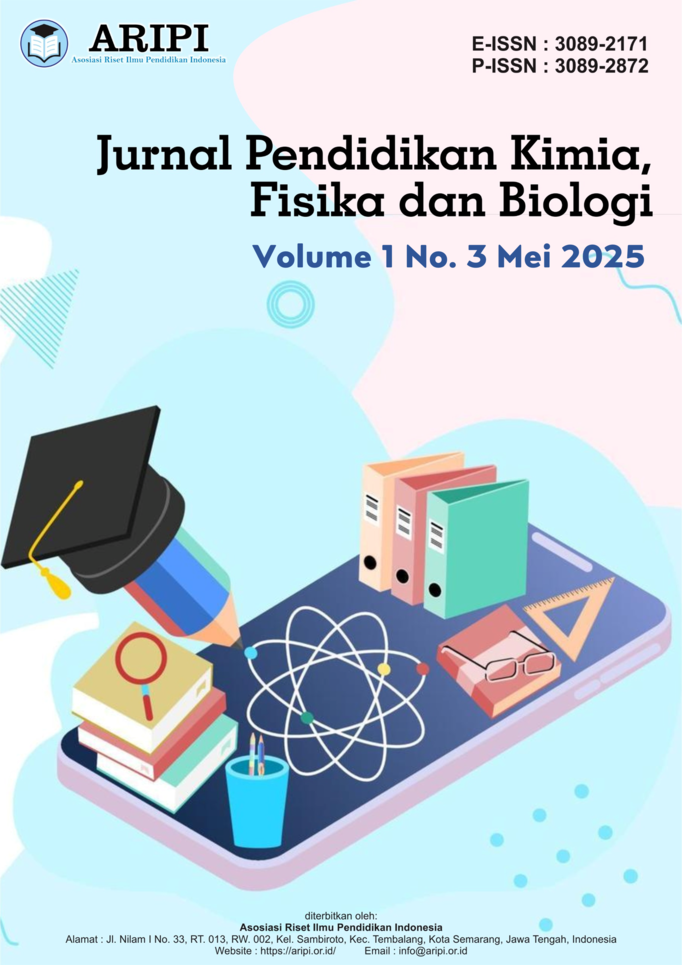Keterkaitan Keterampilan Argumentasi Ilmiah dan Berpikir Kritis Melalui Model Pembelajaran VAK pada Materi Sel
DOI:
https://doi.org/10.61132/jupenkifb.v1i3.249Keywords:
Critical Thinking, Scientific Argumentation, VAK Learning Model (Visual, Audiotory, Kinestetik)Abstract
Scientific argumentation skills are high-level thinking skills that are very important for students to have in the learning process, especially in 21st century education that shapes students to argue and shape students into individuals who are able to think critically. However, based on the results of observations, students are still not active in conveying their arguments and critical thinking. The purpose of this study is to analyze the relationship between scientific argumentation skills and critical thinking skills through the VAK (Visual, Auditory, Kinesthetic) learning model on cell material. The method used in this study is the correlational method with an ex post facto research design using 1 experimental class with a research sample of 30 students. The instruments used are 15 essay questions for both scientific argumentation skills and critical thinking skills. Data analysis was carried out using Microsoft Excel and data analysis techniques using the t-test. The results of the analysis through the posttest on students' scientific argumentation skills are in the form of an average value of 47.5, while the average value of critical thinking skills is 47.6, with the results of the t-test being 2.08> 1.69, which means that tcount> ttable, namely H0 is rejected. The results of the hypothesis test show a significant relationship between scientific argumentation skills and critical thinking skills using the VAK (Visual, Auditory, Kinesthetic) learning model on cell material.
References
Aji Setiawan, & Siti Alimah. (2019). Pengaruh Model Pembelajaran Visual Audiotory Kinestetik (VAK) Terhadap Kreatif Siswa. Jurnal Profesi Pendidikan Dasar: 6(1).
Dewi et.al. 2019. Analisis Kemampuan Berpikir kritis Matematis Siswa SMP Pada Materi Lingkaran Dan Bangun Ruang Sisi Datar. Jurnal Pembelajaran Matematika Inovatif. 2(6), 371-378.
Evi Rovati. 2019. Kontribusi Argumentasi Ilmiah dalam Pengembangan Keterampilan Berpikir Kritis. Jurnal ilmiah multi Sciense. 11(2), 56-66.
Facione & Gittens. 2015. Critical Thinking: A Statement of Expert Consensus for Purposes of Educational Assessment and Instruction. Executive Summary of The Delphi Report. The California Academic Press, California
Farida, I, C & Gusniarti, W. F. (2020). Profil Keterampilan Argumentasi Siswa Pada Konsep Koloid yang Dikembangkan Mellaui Pembelajaran inkuiri Argumnetatif. Jurnal Edusains, 6(1).
Fatmawati, R. D., & Ramli, M. (2019). Meningkatkan Kemampuan Argumentasi Siswa Melalui action Resecrh dengan Fokus Tindakan Think Pair Share. Jurnal Bioedu Confirm, 15(1).
Fatonah. 2017. Pengaruh Model Pembelajaran Visual Auditori Kinestetik Terhadap Hasil Belajar Kognitif Peserta Didik Kelas Viii Smp. Jurnal Pijar MIPA, 6(4).
Febrianti dan Zanthy. 2019. Analisis Kemampuan berpikir Kritis Matematis Siswa. Jurnal Educatin. 4(6).
Jihan. D. H. et.al. 2024. Analisis Kemampuan Berpikir Kritis Matematis Siswa SMA Dalam Soal High Order Thinking Skill. Jurnal Pengabdian Kepada Masyarakat. 3(1), 49-60.
Khun. et.al. 2017. Thinking Together and Alone. Educational Resercher. 44(1), 46-53.
Megatro, T. W. W. et.al. 2021. Analisis Keterampilan Argumentasi ilmiah Peserta Didik Pada Model Pembeljaran Berbasis Toulmin’s Argumentation Pattern (TAP) Dalam Memehamai Konsep Fisiska Dengan Metode Library Reserch. Jurnal of Science Education. 5(1), 79-91.
Nasrullah et.al. 2021. Kemampuan Berpikir Kritis Matematis Siswa Pada Pembelajaran Realistic Mathematics Education (RME). Jurnal Pendidikan Matematika 12(1).
Ni Nyoman, P., I Putu, P. S., & Ratih, A. S. (2019). Belajar dan Pembelajaran. Edisi 2. Perpustakaan Nasional: Katalog Dalam Terbitan (KDT) Depok.
Nur Fitriyani. 2023. Implementasi Model Pembelajaran VAK (Visual Auditorial Kinestetik) dalam Mengembangkan Efikasi Diri Sisiwa Kelas VII. Jurnal Kajian dan Pengajaran. 9(2), 201-207.
Oliveras et.al. 2017. The Use of Newspaper Articles as a Tool to Develop Critical Thinking in Science Classes. International Journal of Science Education, 35(6), 885-905.
Rahmayani, B, dkk. 2023. Hubungan Strategi Pembelajaran Dengan Kemampuan PelajarLuar Biasa. Jurnal Inspiras Pendidikan, Vol. 1 No. 1, 196-202.
Riwayani. R. et.al. 2019. Analisis Kemampuan Argumentasi ilmiah Siswa pada Materi Optik:Problem Based Learning Berbantuan Edu-Media Simulation. Jurnal inovasi Pendidikan. 5(1), 45-53.
Sertiono. P. et al. 2021. Kemmapuan argumentasi ilmiah mahasiswa melalui penerapan model pembelajaran project based learning. Elementary school education jurnal. 5(1), 101-111.
Setian Y. T. et. al. 2022. Keterampilan Berfikir Kritis Pada Pembelajaran IPA Menggunakan Model Pembelajaran Redec di Sekolah Dasar: Systematic Literature Reiew. Jurnal Sains dan Teknologi. 5 (2), 133-141.
Suraya, Anandita,E. S., Nuri, D. M. (2019). Argumentasi ilmiah dan Keterampilan Berpikir Kritis Melalui Metode Debat. EDUSAINS, 11(2).
Suryani Lely. 2020. Hubungan Efikasi Diri dan Motivasi Belajar Terhadap Hasil Belajar Berbasis E-Learning Pada Mahasiswa Program Studi Pendidikan Matematika Universitas Flores. Jurnal Kependidikan. 6(2).
Wiedarti. (2018). Pentingnya Memahami Gaya Belajar. Jakarta: Direktorat Jenderal Pendidikan Dasar dan Menengah Kementerian Pendidikan dan Kebudayaan.
Downloads
Published
How to Cite
Issue
Section
License
Copyright (c) 2025 Jurnal Pendidikan Kimia, Fisika dan Biologi

This work is licensed under a Creative Commons Attribution-ShareAlike 4.0 International License.





